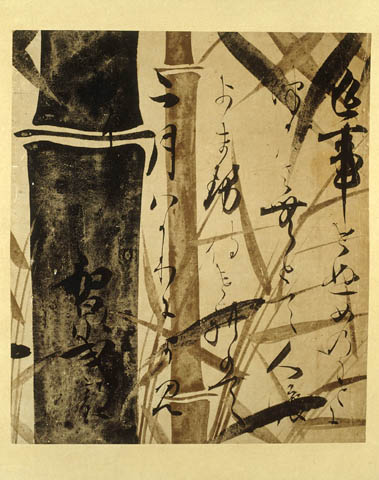| architecture |
| calligraphy |
| ceramics |
| clothing |
| comics |
| gardens |
| lacquerwork |
| literature |
| movies |
| music |
| painting |
| poetry |
| sculpture |
| tea ceremony |
| television |
| theatre |
| weaponry |
| thematic routes |
| timeline |
| the site |
context: painting > general comments
Links to calligraphy and poetry

|
calligraphy by Hon'ami Koetsu, art by Tawaraya Sotatsu |
As you'll see from looking at much old painting, and quite a lot of modern painting too, there are words on the same surface. Sometimes they are out of the way off to one side or up above, but they aren't supposed to be chopped off, as most reproductions (including some on this site) do. They were part of the work - in some (maybe most) cases, the most important part. In some cases they are integral - I think the image on this page is a great example of painter and calligrapher working together to make something greater than the sum of the parts.
The highest form of art in Japan was long considered to be the painting with poetry - that's three elements, as the calligraphy was, if anything, the most highly regarded of the three. Sometimes any two, or even all three, of the elements would be by the same person, sometimes it would be three separate people who may have never met. An artist would produce an image and the patron would take it to some poets and ask them to write something, so there might be half a dozen different hands responsible for the words. Artists would design backgrounds for calligraphers to work on (Sotatsu did this a great deal for Koetsu, for instance). Artists would take old poems or zen sayings and paint something to fit, then write the poem on the scroll, or have someone else do so. There were no rules as to how it worked. An interesting aspect of much Zen art of the last 400 years is that producing paintings and producing calligraphy feels very like the same thing, the same sort of brushwork with the same kind of intent, a kind of bizarrely obscurantist didacticism. They don't seem like different activities at all, and this seems to have become more and more true of the monastic Zen art in modern times.
I discuss this further in the calligraphy section, particularly under 'difficulty'. It all means that I'll be giving lots more attention to the painting than to the poetry or the calligraphy. I'm making an effort, but I want to highlight that I'm neglecting what, to the Japanese, is much of the best of their cultural history, and I'm in no position to suggest that they are wrong.
